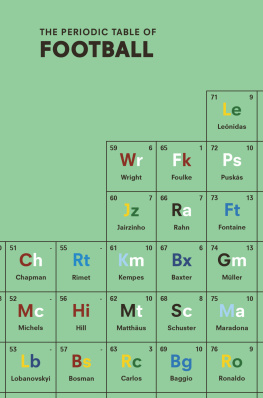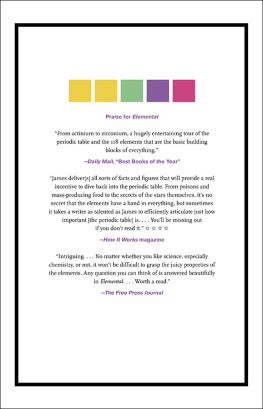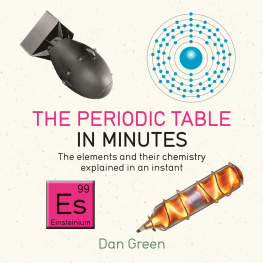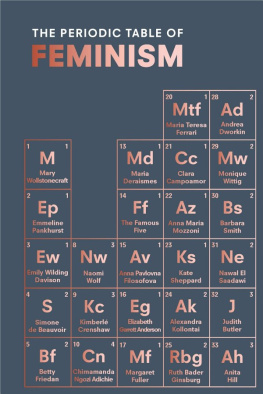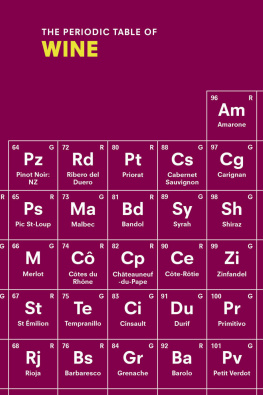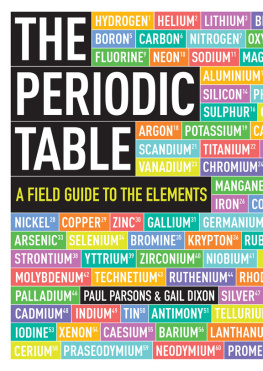Geoffrey Rayner-Canham - Periodic Table, The: Past, Present, And Future
Here you can read online Geoffrey Rayner-Canham - Periodic Table, The: Past, Present, And Future full text of the book (entire story) in english for free. Download pdf and epub, get meaning, cover and reviews about this ebook. year: 2020, publisher: World Scientific Publishing Company, genre: Home and family. Description of the work, (preface) as well as reviews are available. Best literature library LitArk.com created for fans of good reading and offers a wide selection of genres:
Romance novel
Science fiction
Adventure
Detective
Science
History
Home and family
Prose
Art
Politics
Computer
Non-fiction
Religion
Business
Children
Humor
Choose a favorite category and find really read worthwhile books. Enjoy immersion in the world of imagination, feel the emotions of the characters or learn something new for yourself, make an fascinating discovery.
- Book:Periodic Table, The: Past, Present, And Future
- Author:
- Publisher:World Scientific Publishing Company
- Genre:
- Year:2020
- Rating:4 / 5
- Favourites:Add to favourites
- Your mark:
- 80
- 1
- 2
- 3
- 4
- 5
Periodic Table, The: Past, Present, And Future: summary, description and annotation
We offer to read an annotation, description, summary or preface (depends on what the author of the book "Periodic Table, The: Past, Present, And Future" wrote himself). If you haven't found the necessary information about the book — write in the comments, we will try to find it.
Periodic Table, The: Past, Present, And Future — read online for free the complete book (whole text) full work
Below is the text of the book, divided by pages. System saving the place of the last page read, allows you to conveniently read the book "Periodic Table, The: Past, Present, And Future" online for free, without having to search again every time where you left off. Put a bookmark, and you can go to the page where you finished reading at any time.
Font size:
Interval:
Bookmark:




Published by
World Scientific Publishing Co. Pte. Ltd.
5 Toh Tuck Link, Singapore 596224
USA office: 27 Warren Street, Suite 401-402, Hackensack, NJ 07601
UK office: 57 Shelton Street, Covent Garden, London WC2H 9HE
British Library Cataloguing-in-Publication Data
A catalogue record for this book is available from the British Library.
THE PERIODIC TABLE
Past, Present, and Future
Copyright 2020 by World Scientific Publishing Co. Pte. Ltd.
All rights reserved. This book, or parts thereof, may not be reproduced in any form or by any means, electronic or mechanical, including photocopying, recording or any information storage and retrieval system now known or to be invented, without written permission from the publisher.
For photocopying of material in this volume, please pay a copying fee through the Copyright Clearance Center, Inc., 222 Rosewood Drive, Danvers, MA 01923, USA. In this case permission to photocopy is not required from the publisher.
ISBN 978-981-121-848-4 (hardcover)
ISBN 978-981-121-849-1 (ebook for institutions)
ISBN 978-981-121-850-7 (ebook for individuals)
For any available supplementary material, please visit
https://www.worldscientific.com/worldscibooks/10.1142/11775#t=suppl
Typeset by Stallion Press
Email:
Printed in Singapore
About the Author
Geoff Rayner-Canham, FCIC, FRSC, has published widely on aspects of chemistry education, particularly inorganic chemistry. With Tina Overton, he is coauthor of Descriptive Inorganic Chemistry, which is currently in its 6th edition and which has been translated into six other languages. Geoffs main research focus has been on the history of women in science particularly chemistry. This research has been undertaken jointly with his partner, Marelene Rayner-Canham. In addition to many research papers, they have coauthored six books, the latest being Pioneering British Women Chemists: Their Lives and Contributions.
For 20 years, accompanied by some of his students, Geoff has taken chemistry outreach to remote and isolated schools in rural Newfoundland, Labrador, Nunavut, and coastal Quebec. He has also been coauthoring a series of articles with his Inuk student, Chaim Andersen, on Chemistry and Inuit Life & Culture.
With his colleague, Debbie Wheeler, Geoff codeveloped, and has been coteaching, the first online distance chemistry courses offered by Memorial University. One of the courses received a Canadian award for innovation in distance course technology. Students from as far away as Wuhan, China, and Sydney, Australia, have taken these courses. For his outreach and for excellence in chemistry teaching, Geoff has received the Chemical Institute of Canada, Chemical Education Award; the National Science and Engineering Research Council of Canada PromoScience Award; and a 3M Teaching Fellowship.
Geoff continues to teach and undertake research at the Grenfell Campus, Memorial University, Corner Brook, Newfoundland & Labrador, Canada, where he currently holds the rank of Honorary Research Professor.
Contents
Introduction
Periodic Properties? Thats easy! Properties down a couple of Groups, properties across a sample Period, done! A not uncommon view. Yet there is a richness of relationships, some obvious, some not, which makes an in-depth look at the chemical elements a rewarding adventure. Ronald Rich eloquently described the lure of periodicity in all its manifestations:
One of the fascinations of inorganic chemistry is the existence of a wide variety of relationships among the elements and their properties-relationships that show an encouraging degree of order, but a tantalizing variability and novelty. These qualities make the family of elements an apt metaphor: while members of a family have much in common, each member also has his[/her] own individual personality.
There have been some 20th century monographs on chemical periodicity. However, to be honest, the old Periodic Table monographs are boring no, very boring no extremely boring. As are the chapters on the Periodic Table in most textbooks. A litany of dry facts usually emphasizing that everything can be explained in terms of Groups and Periods; that everything is known; that there is only one definitive Periodic Table; and that apart from the genius of Mendelev, rarely is any other human involvement described.
How incredibly far from the truth in all these factors!
The Periodic Table is fascinating as I hope, you, the Reader, will discover.
Groups and Periods are only one small facet of linkages among the chemical elements.
There are still avenues of exploration and with many discoveries, new possibilities arise.
There is no one-fits-all-uses Periodic Table there are different arrangements to better explain some aspect of element linkages.
The Periodic Table is a human construct, as can be seen from the names mentioned herein. And in recent times, seven individuals, in particular, have contributed greatly to modern philosophies of the Periodic Table and of the elements therein: Stephen Hawkes, William Jensen, Michael Laing, Pekka Pyykk, Guillermo Restrepo, R. T. Sanderson, and Eric Scerri. The Reader will see their names (and many others) sprinkled in the text and among the Chapter References.
This book is not a data-filled comprehensive (and boring) compilation. Instead, by looking at some patterns and trends from different perspectives, the Author hopes that the Reader will find this book stimulating and thought-provoking. Without doubt, there are additional interesting and/or curious linkages and patterns of which the Author is unaware. Any Reader spotting an overlooked similarity or pattern is asked to bring it to the attention of the Author at: .
In closing, my Grenfell colleague Chris Frazee, and my partner, Marelene Rayner-Canham, are thanked for reading the entire manuscript (Marelene, many times) in an endeavor to minimize the errors therein.
Geoff Rayner-Canham
Chapter 0
The Periodic Table Exploration Begins!
The time has come, the Walrus said,
To talk of many things:
Of shoesand shipsand sealing wax
Of cabbagesand kings
And why the sea is boiling hot
And whether pigs have wings.
Thus spake the Walrus to the Carpenter (].
Here, in this treatise, Gentle Reader, you will be led through the world of the Periodic Table; a world even more exciting, more wondrous, more bizarre, than anything Lewis Carroll could have ever imagined.
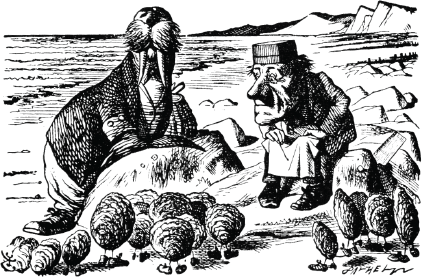
Figure 0.1 The Walrus, the Carpenter, and the Little Oysters.
Reference
Chapter 1
Isotopes and Nuclear Patterns
In the early decades of modern chemistry, atomic mass (weight) of an element was a major topic for debate and heated dispute. The original Periodic Tables were constructed in terms of order of atomic mass. Any irregularities in order were excused away. With the discovery of atomic number and its use as the foundation of the modern Periodic Table, inorganic chemists seem to have largely ignored patterns in element isotopes. Not only do such patterns explain average atomic mass irregularities, but they reveal some fascinating nuclear chemistry. In addition, the shell model of the nucleus is important in the synthesis of new chemical elements.
Font size:
Interval:
Bookmark:
Similar books «Periodic Table, The: Past, Present, And Future»
Look at similar books to Periodic Table, The: Past, Present, And Future. We have selected literature similar in name and meaning in the hope of providing readers with more options to find new, interesting, not yet read works.
Discussion, reviews of the book Periodic Table, The: Past, Present, And Future and just readers' own opinions. Leave your comments, write what you think about the work, its meaning or the main characters. Specify what exactly you liked and what you didn't like, and why you think so.





